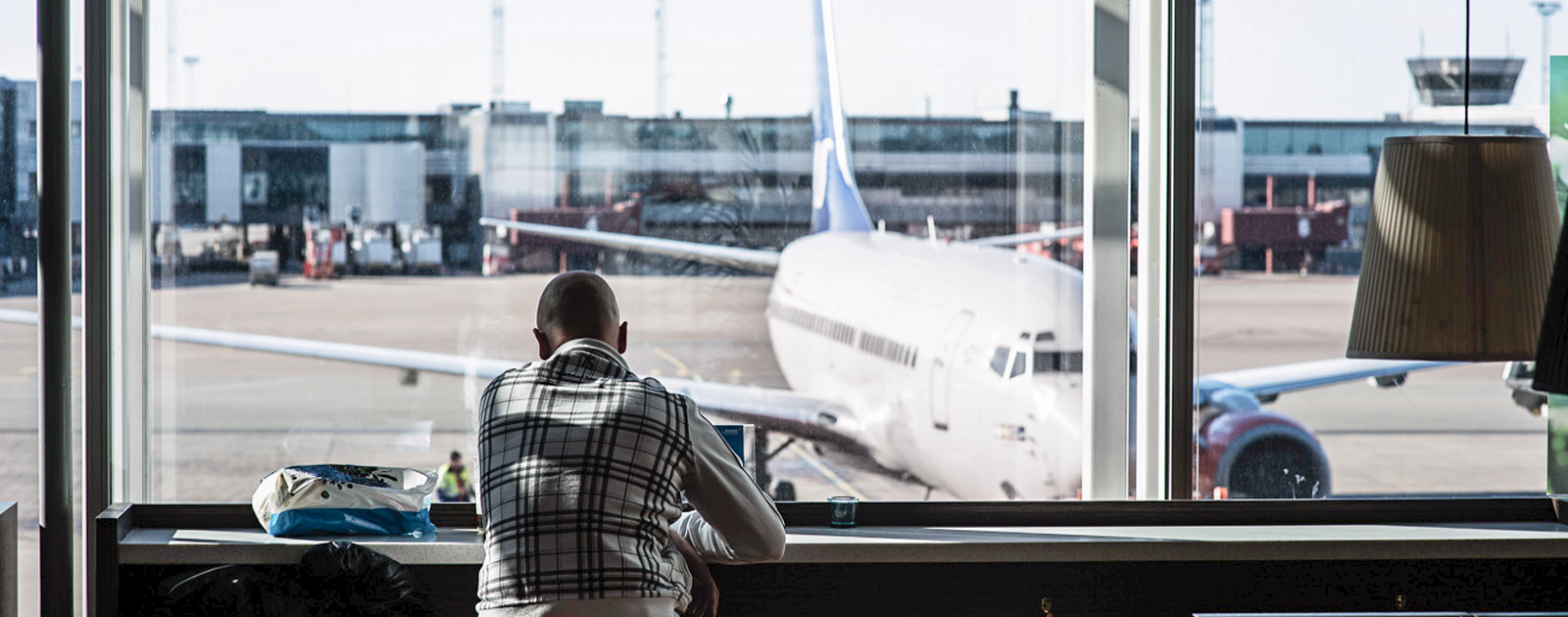Role and mission
We develop the airports of the future and create sustainable growth for Sweden
Swedavia's role
Swedavia’s mission is to own, operate and develop the airports in Sweden’s national basic infrastructure. Swedavia connects Sweden's regions with each other and with the rest of the world. Swedavia owns the ten airports but Ronneby Airport and Luleå Airport are partly owned by the Swedish Air Forces, but Swedavia is responsible for commercial air traffic.
The company was formed in 2010 and is wholly owned by the Swedish State. In 2024, Swedavia's airports had 32.5 million passengers, compared to 32.1 million in 2023. This is an increase of 0.4%.
Annual and Sustainability Report 2024, pdf
Purpose
Together we enable people to meet.
Vision
Swedavia develops the airports of the future and creates sustainable growth for Sweden.
Business idea
Together with its partners, Swedavia creates added value for its customers by offering attractive airports and access that provide smooth and inspiring travel experiences. Swedavia's airports shall be the most important meeting places in Scandinavia, while the Company shall be an international role model in sustainability and a growth engine for all of Sweden.
Values
Reliable
Engaged
Innovative
Welcoming
The net-zero airports of the future
Swedavia is a world leader in operating airports with the least possible environmental impact, and it will continue to be so. Swedavia is also driving the development of sustainable air transport of the future, where air travel generates the least possible impact on the environment and enables smooth and efficient travel to, from and within Sweden. Fossil fuels will be phased out.
Swedavia's ten airports
In 2021, Swedavia's four international airports were organized in a joint airport organization, International Airports. Other airports formed Regional Airports.
International Airports
Stockholm Arlanda Airport
Bromma Stockholm Airport
Göteborg Landvetter Airport
Malmö Airport
Regional Airports
Kiruna Airport
Luleå Airport
Umeå Airport
Åre Östersund Airport
Visby Airport
Ronneby Airport
Performance in 2023
- 32.5 million passengers (32.1 million in 2023), an increase of 0.4%.
- Net revenue increased to 6,393 million SEK (5,931 million SEK in 2023).
- Operating profit amounted to 26 million SEK (-318 million SEK in 2023).
- The Group's investments amounted to 1,790 million SEK (2,010 million SEK in 2023).
- In 2024, a provision was made for the future repayment of a shareholder contribution of 204 million SEK, along with interest of 20 million SEK.
- The Board of Directors proposes that no dividend be distributed by Swedavia AB for the financial year 2024.
Operations
Our airports
Stockholm Arlanda Airport
- 22.7 million passengers in 2024, an increase of 4.2% compared to 2023
- 157 destinations, of which 22 are domestic
Gothenburg Landvetter Airport
- 5.3 million passengers in 2024, an increase of 2.9% compared to 2023
- 79 destinations, of which 3 are domestic
Bromma Stockholm Airport
- 1.0 million passengers in 2024, a decrease of 14.9% compared to 2023
- 13 destinations, of which 11 are domestic
Malmö Airport
- 0.9 million passengers in 2024, a decrease of 30.2% compared to 2023
- 18 destinations, of which 3 are domestic
Luleå Airport
- 1.0 million passengers in 2024, a decrease of 5.4% compared to 2023
- 13 destinations, of which 4 are domestic
Umeå Airport
- 0.7 million passengers in 2024, a decrease of 1.5% compared to 2023
- 10 destinations, of which 2 are domestic
Åre Östersund Airport
- 0.2 million passengers in 2024, a decrease of 5.4% compared to 2023
- 6 destinations, of which 2 are domestic
Visby Airport
- 0.3 million passengers in 2024, a decrease of 7.6% compared to 2023
- 9 destinations, of which 6 are domestic
Ronneby Airport
- 0.1 million passengers in 2024, a decrease of 8.3% compared to 2023
- 1 domestic destination (Stockholm)
Kiruna Airport
- 0.2 million passengers in 2024, an increase of 2.2% compared to 2023
- 3 destinations, of which 1 is domestic
Focus on the customer
The business of an airport ultimately revolves around passengers. Passengers are the main focus of operations that the airport operator, airlines, suppliers and tenants carry out at Swedavia’s airports.
Airport operations
Owns, operates and develops Swedavia’s airports across Sweden.
Aviation Business
- Passenger services
- Take-off and landing services
- Security screening
- Terminal and en route services
- Assistance services, PRM*
- Infrastructure for ground handling services**
- Ground handling services
* * People with reduced mobility
**Ground handling services: include baggage handling and refuelling
Commercial Services
- Rental of premises for retail, restaurants, offices, warehousing and logistics
- Car parking
- Advertising, data and other services
Real Estate operations
Owns, develops and manages properties and developable land at and in the vicinity of Swedavia’s airports
- Preparation of property development projects for hotels, offices, logistics, retail etc.
- Administration and updating of information about properties
- Services in construction project management
- Development of jointly-owned property companies
Objectives and targets
Swedavia measures and reports the outcome for five mission goals for which no target has been set. The function goal pertains to how access shall be developed for citizens and businesses. The concern goal describes how the Swedish transport system shall be developed in terms of traffic safety, environment and health.
Swedavia’s strategies for sustainable development
Swedavia’s strategies shall together contribute to achieving all of the Company’s objectives and targets. One important factor for successful implementation is that the strategies provide the conditions needed for cross-functional collaboration throughout the Group.
Commercial excellence
Swedavia’s operations enable the establishment of attractive air links. We create an innovative customer offering in retail, services and property. The basis of this is understanding customers’ current and future needs and ensuring that Swedavia has the ability to offer and deliver products and services that are competitive and create value for the customer and for Swedavia. Swedavia evaluates its core operations on a continuous basis, reviews its business models and develops business through innovation and digitisation.
Swedavia intends to develop new business and revenue models, establish its airport cities as attractive marketplaces, establish methods for customer-centred ways of working, strengthen and develop good external relations and communicate the Company’s drive and success to Swedavia’s customers.
Operational excellence
Swedavia works to deliver efficient, flexible and automated infrastructure. It means Swedavia delivers services and products that meet customers’ demands and expectations by optimising the use of available infrastructure and resources, automating processes and flows and adopting digitisation and innovative solutions. It means Swedavia works in an efficient, cost-effective way and that the Company continuously improves and develops its delivery and cost-effectiveness. It also means that Swedavia has clearly defined products, services and processes, operationally and commercially.
It is important to have active strategic work for operational excellence, but this is also a challenge when many of Swedavia’s airports have capacity restrictions and at the same time major development projects are being carried out to enhance this capacity.
Swedavia works to improve flows and processes, to increase cost-effectiveness in the Company’s processes, and to ensure an optimal, clearly defined governance model.
Increased capacity
Swedavia enhances both its operational and commercial capacity by developing the airports of the future, in order to meet both current and future customer needs. Increased capacity means that Swedavia, in its own operations and through partners and contractors, ensures that resources and skills are available to carry out current and future development programmes on time, on budget and with no worksite accidents.
Engaging culture
Swedavia creates opportunities for employees to grow and develop in an inclusive environment. This is the basis for ensuring that all employees together will be able to work towards and achieve Swedavia’s shared objectives and targets. It means that employees are offered opportunities and rights to develop. At the same time, they must take responsibility, meet obligations and act in accordance with our values.
An engaging culture means that Swedavia actively works with inclusion to achieve diversity. This contributes to better performance, creativity, innovation and understanding of Swedavia’s customers. Swedavia also strives to be an attractive employer that can attract, develop and retain the best employees. That is an essential condition for our long-term success.
An engaging culture is a matter of ensuring access to skills in the short and long term, creating an inclusive culture that involves and develops people, enhances the conditions needed for innovation and builds pride in Swedavia and the Company’s sustainability work.
Responsibility for society and people
Swedavia works proactively for safety, security, the environment and the health of customers, employees and society in general. It means that safety and security are fundamental to everything Swedavia does, that the Company uses resources and energy in a responsible and efficient way and that it gives priority to the physical and psychosocial workplace environment.
Swedavia goes farther than it is legally obliged to, which serves as a basis for the Company’s ambition to be an international role model in sustainability.
In assuming its social and environmental responsibility, Swedavia works among other things to raise the level of safety and security at the airports, strengthen its proactive and systematic workplace environment work, be a driving force in the aviation industry’s switch to renewable jet fuel and adopt climate-smart energy solutions.
Swedavia has also identified and is carrying out initiatives that entail safeguarding and developing the Company’s business ethics and further developing its risk and crisis management and its continuity planning.
Development of airports
Capacity is ensured through an accelerated investment rate
The number of passengers at Swedavia’s airports is expected to increase over time.The increase will mostly take place at airports with many international connections. Swedavia therefore needs to ensure sufficient terminal, gate and runway capacity to meet this growth.
A number of refurbishmentand expansion projects were carried out at the regional airports. At the airports in Kiruna, Luleå and Umeå, this was done through joint funding with the regions affected. Now resources are being concentrated mainly on Stockholm Arlanda Airport, Göteborg Landvetter Airport and Bromma Stockholm Airport.
Alongside measures to increase capacity, Swedavia is also increasing opportunities to develop the atmosphere at the airports and enhance the commercial offering in the form of moreshops, cafés and restaurants.
Stockholm Arlanda Airport
In December 2013, Swedavia decided on its approach to the long-term development of Stockholm Arlanda Airport. During the period 2016–2025 investments are planned for SEK 21.3 billion. In the first phase, resources will be concentrated on meeting the increased demand for international connections with a new pier in Terminal 5. An investment was made in a new baggage facility in Terminal 2, and a new multi-storey parking facility was completed.
Swedavia also intends to invest three to four billion kronor in developing properties adjacent to the airport. Such capital spending can generate a return through the sale of properties and be reinvested in the development of the airports.
Read more about Arlanda's development program here
Göteborg Landvetter Airport
Göteborg Landvetter Airport recently completed a major refurbishment, but here too, investment in increased capacity is necessary in the long term. Measures completed during the year include the opening of the terminal area between domestic and Schengen traffic, thus improving use of the building. Going forward, new logistics properties will be developed adjacent to the airport, and commercial space will be expanded in the long term.
Read more about Landvetter's development program here
Bromma Stockholm Airport
The investments that Swedavia is making at Bromma Stockholm Airport are being carried out in compliance with the requirements that the Swedish Transport Agency has placed on operations. In addition, investments to improve the atmosphere at the airport are also being carried out.
Read more about Bromma's development program here
Master plans identify the airports’ future needs
The airports’ really long-term plans are called master plans. A master plan is a guiding document that deals with the airport’s development over the very long term. The master plan identifies the airport’s future needs and shows in a visionary way how the airport can meet these needs.
The first plans were adopted in February 2017, and the most recent one was produced in September 2019.
The plans for Stockholm Arlanda Airport and Göteborg Landvetter Airport are draft master plans, which means that they are general, indicative plans. They have been prepared in order to quickly provide an overall plan that can be used in dialogues with internal and external stakeholders and thus get input into the continuing work with these master plans.
In order to use these plans more practically, all sections of the plans require more in-depth analyses. Master plans for Stockholm Arlanda Airport and Göteborg Landvetter Airport are now being developed.
The airports' adopted master plans (in Swedish)
Ronneby Airport, pdf 1 Mb
Visby Airport, 1 Mb
Umeå Airport, pdf 2 Mb
Stockholm Arlanda Airport, pdf 2 Mb
Draft Göteborg Landvetter Airport, pdf 5 Mb
Malmö Airport, pdf 3 Mb
Kiruna Airport, pdf 4,5 Mb
Luleå Airport, pdf 3 mb
Responsibility for master planning
The responsibility for master planning in the International Airports group is held in Facilities & Systems by the management. For the regional airports, responsibility is held locally at each airport.
Almedalen week
This is to help increase understanding of and knowledge about Swedavia’s mission and role in social development, and about our importance of air travel for Sweden’s competitiveness, economic growth and prosperity. We also want to increase knowledge about Swedavia’s and the aviation industry’s work to reduce the climate impact and transform air travel to make it sustainable.
Swedavia at Almedalen Week
The aviation industry, political leaders and business executives need to discuss together how access to, from and within Sweden can increase – and how this is to be done in a sustainable way. Surveys show that our country is a world leader in a comparison of various critical conditions needed to create a good future. However, there is one category where we lag behind – Sweden’s international access – with significant socioeconomic decline as a result.
Sweden’s geographic shape and location require air travel. We are also a country that is highly dependent on both imports and exports, and we have a tourism industry that is growing ever stronger. Without direct routes to destinations in strategically important regions around the world, our opportunities are limited.
At the arena Aerospace Almedalen, Swedavia – together with a number of partners in the air travel and aerospace industry – conducts an extensive one-day programme. To see a presentation in more detail (in Swedish), visit www.aerospacealmedalen.se
Swedavia’s history at Almedalen Week
Until 2018, Swedavia held seminars in its own venue, Gate Almedalen, at which our partners also participated. Since 2019, we have instead chosen to be part of Aerospace Almedalen.


